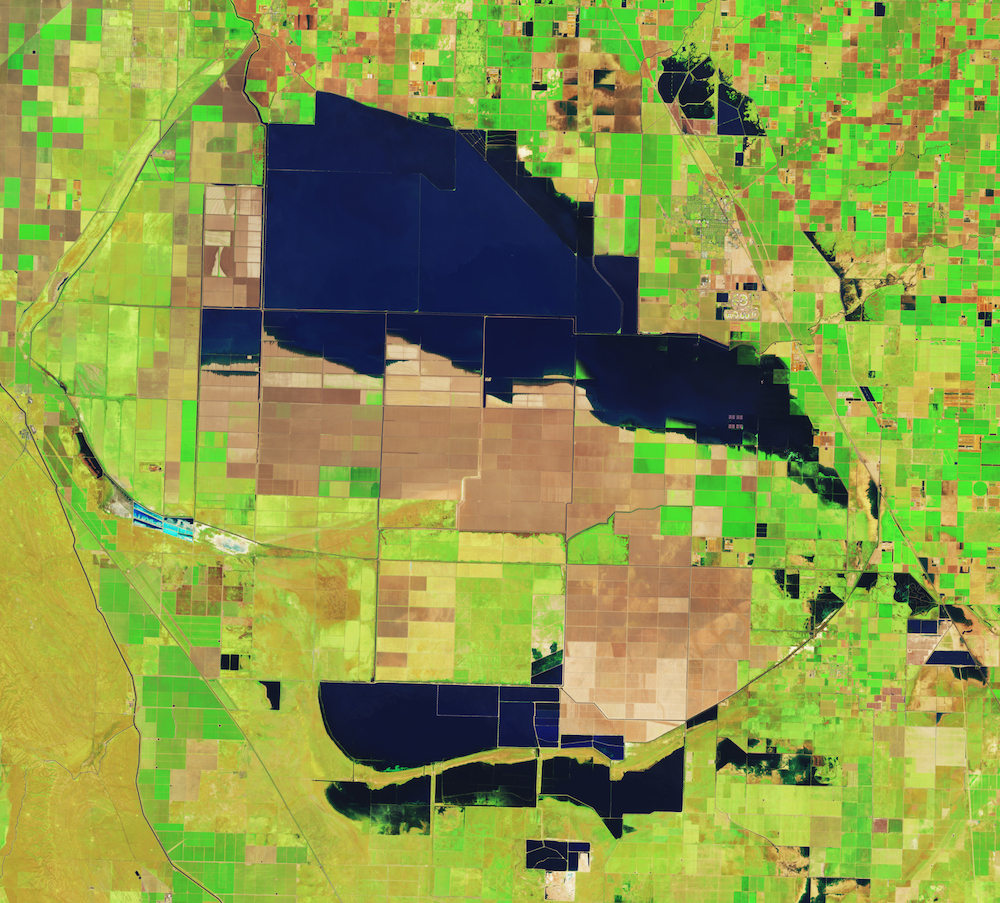
New images from NASA show the flooding of the Tulare Lake bed from April 30.
As Tulare Lake flood water creeps ever closer to the small city of Corcoran, officials at the two state prisons there have stopped accepting inmate transfers while they develop larger evacuation plans.
Together, the prisons house 8,000 people, many with severe mental health and substance abuse issues as well as rival gang members.
So, the California Department of Corrections and Rehabilitation has stopped accepting incoming transfers, according to a spokesperson.
Though speculation has been rampant that the prisons have already begun moving inmates “of concern” out of the flood zone, the CDCR spokesperson said, “incarcerated persons are not being moved out at this time beyond normal institution operations.”
A “slow burn”
The old Tulare Lake bed, drained for farming more than 100 years ago, is rapidly refilling with flood water.
The only thing standing between the returning lake and the prisons, is the Corcoran levee, which has been sinking over the years because of excessive groundwater pumping.
The City of Corcoran and Cross Creek Flood Control District scrambled to rebuild the levee up to 191 feet after it had sunk to 188 feet. Floodwater lapping at its western and southern flanks is at 179 feet, according to Kings County Sheriff Dave Robinson.
Work on the levee protecting the town and the prisons may need to continue since flood water could stick around for up to two years.
The two state prisons, the California State Prison, Corcoran and the California Substance Abuse Treatment Facility, are just inside the southern arm of the levee.
Numerous people have been asking how the prison populations would be moved in case flood water reaches the institutions.
But CDCR staff and others have been tightlipped about evacuation plans and even potential flooding risk.
A CDCR spokesperson would not reveal or confirm any details concerning evacuation and responded only with, “For safety and security purposes, details regarding the evacuation plan are not public,” via email.
Staff from Kings County Office of Emergency Services declined to discuss the prisons without clearance from CDCR.
Safe for now
For now, the prisons should be safe, Sheriff Robinson said. The situation won’t become severe unless the water rises about eight more feet or there’s a levee breach, he said. Then, evacuation may become a reality.
“This is a slow burn, slow rise, where we’re going to be able to give people plenty of time,” said Robinson. “If there’s no breach and it’s just a raising of the water, we’re going to be able to give people probably anywhere from two weeks to 30 days notice.”
The prisons have two evacuation plans. One is a quick turnaround plan and the other is more slowly paced, said Robinson.
After weeks of drenching the valley and washing snow down from lower elevations, the weather has finally become an ally of flood weary residents. Cooler temperatures have slowed runoff from the massive snowpack – at least for the time being.
Water is flowing into the lakebed from the Kings river at about 2,500 cubic feet per second, said Robinson. That’s about 5,000 acre feet a day and 150,000 acre feet per month, if it remains steady at that rate.
Other sources coming into the lake, the Kaweah and Tule rivers, have both throttled back as well with irrigation demand soaking up much of their excess flows. Water from the Kern River, is so far, being held in check as it’s funneled to irrigation or into recharge basins in Kern County.
One of the worst case scenarios would be a heat wave, which would rapidly melt the historic snowpack in the Sierra Nevada mountains and send that water barreling down to the lakebed. But even in that situation, it will still take 24-36 hours for the water to reach Kings County, said Robinson.
So, outside of a levee breach, there will be ample time to warn people of what’s coming, he added.
Long haul
Beyond the slow rise of the lake water, there are worries about the longevity of the Corcoran levee. As seen in past historic flood years, the Tulare Lake water can remain on the land for up to two years. That means water could be eroding and putting pressure on the Corcoran levee for a long time.
Roads may also need to be rerouted, sewage and power infrastructure moved and the levee raised even higher, said Brian Ferguson, spokesperson for the California Governor’s Office of Emergency Services.
“This is a lasting challenge that will continue to persist in this community for the long haul,” Ferguson said. “It’s not just what happens over the next six weeks, it could be what happens in the months and years to follow.
“You may need additional containment for many years.”
SJV Water is a nonprofit, independent online news publication covering water in the San Joaquin Valley. Lois Henry is the CEO/Editor of SJV Water. She can be reached at lois.henry@sjvwater.org. The website is sjvwater.org.








